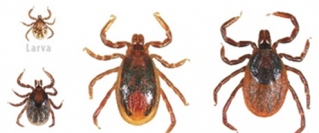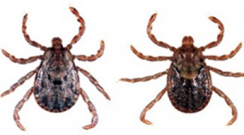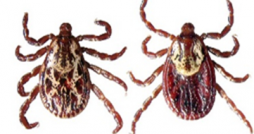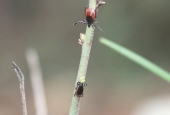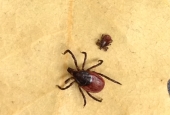Ticks are ectoparasites which feed on the blood of mammals, birds, reptiles, and amphibians. They are in the same group as spiders and mites. There are four stages (eggs, larvae, nymphs and adults) in their life cycle. Both adult and nymphal ticks have eight legs, and larval ticks have six legs. Except for eggs, all three stages require a blood meal to develop into the next stage. Larvae, nymphs and adults acquire disease bacteria by feeding on infected animals.
The Western black-legged tick, Pacific coast tick and American dog tick are the most common ticks that humans encounter outdoors in Alameda County. They are hard bodied ticks with outer shells made of chitin. A less common hard bodied tick, the Brown dog tick, can complete the entire life cycle indoors on dogs or other domestic animals. They do not travel far from the infested dog’s kennel or animal quarters. These four ticks are light beige (larvae and nymphs) to reddish or dark brown (adults) in color. In the adult stage (about 3.2mm long), different species have different markings on the dorsal (top) shell. Both nymphs (2 mm) and larvae (1mm) are tiny and very difficult to spot on the human body and clothing.
Western black-legged tick (Ixodes pacificus)
The western black-legged tick is reddish-brown and can easily be distinguished from other ticks due to its lack of white markings on the dorsal shell. They are the main vectors of Lyme disease, Anaplasmosis, Babesiosis, and Borrelia miyamotoi, a relapsing fever. The adults are about 3 mm in length and prefer living in the wooded areas with oaks, redwood and sycamore trees, as well as in the open grasslands of Alameda County. The nymphs are commonly found under oak trees in their leaf litter. They are present year round in Alameda County but may be more prevalent in certain seasons depending on their life stage. The adults will feed on the blood of large mammals such as deer, dogs, coyotes, horses, and humans. The larval and nymphal stages will feed on blood of lizards and small rodents.



